Volkswagen Atlas Cross Sport Concept 2018
Фольксваген Атлас Кросс Спорт 2020 — компактна версия кроссовера Teramont
Немецкий бренд явно ощущает нехватку кроссоверов в своей модельной линейке, поэтому в 2020 году на американский рынок выйдет переделанный паркетник Atlas, который в России продается под именем Teramont. Ребята из Volkswagen сделали его более агрессивными, пересмотрели внутренний интерьер и добавили к названию Cross Sport.
Цель выпуска обозначена довольно четко – новинка займет нишу между Тигуаном и 7-местным Атласом. Что в итоге вышло, посмотрим ниже.

Технические характеристики
Фольксваген Кросс Спорт комплектуется теми же двигателями, что и донор.
- На борту 2-литровый четырехцилиндровый двигатель на 238 л.с. при 350 Hm с поддержкой турбины.
- 3.6-литровый атмосферник с шестью цилиндрами на 280 л.с. при 360 Hm.
По трансмиссии выбора не будет – исключительно 8-ступенчатый автомат.
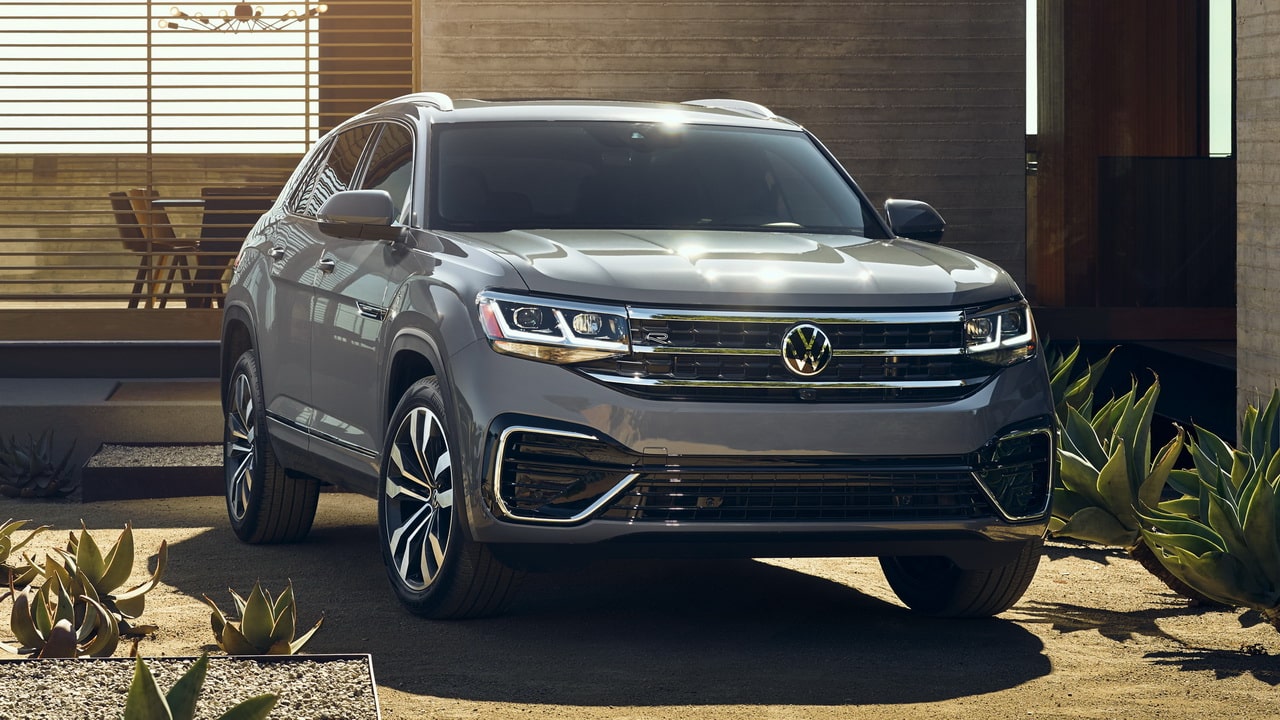
По динамическим показателям информации пока нет, но понятно, что более легкий кроссовер будет разгоняться быстрее своего тяжелого донора, который на 3.6-литровом агрегате выжимал сотку за 7.9 секунд.
Новый кузов привнес несколько изменений в список бортовых функций. Кросс Спорт получил систему контроля слепых зон, автономную АБС и новый адаптивный круиз-контроль.
Комплектация с атмосферником дополнительно оборудуется пакетом буксировки с расчетом до 2270 кг. Стоит отметить, что новый кросс-купе будет продаваться аж в 8 комплектациях. Привод как обычно будет передним в базе и полным в более дорогих вариантах.
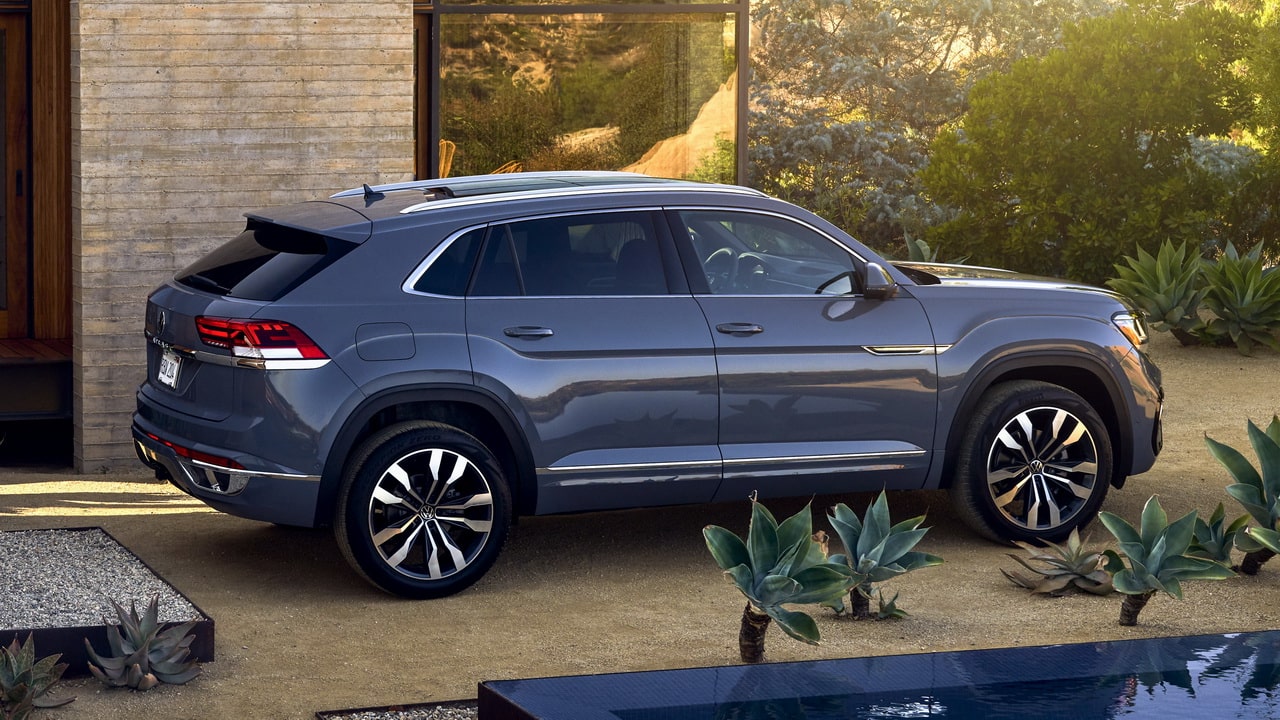
Дополнительно сообщается, что укороченные Атласы получат новую систему Car-Net от Фольксваген, которая отображает состояние всех основных узлов автомобиля на экране смартфона через фирменное приложение.
Внешний вид
Визуально Atlas Cross Sport остался похож на своего донора, но габариты поменялись. Обрезали не так много, но все же. Теперь длина составляет 4966 мм (срезали 71 мм), из-за меньшего клиренса высота стала на 58 мм меньше – 1720 мм.
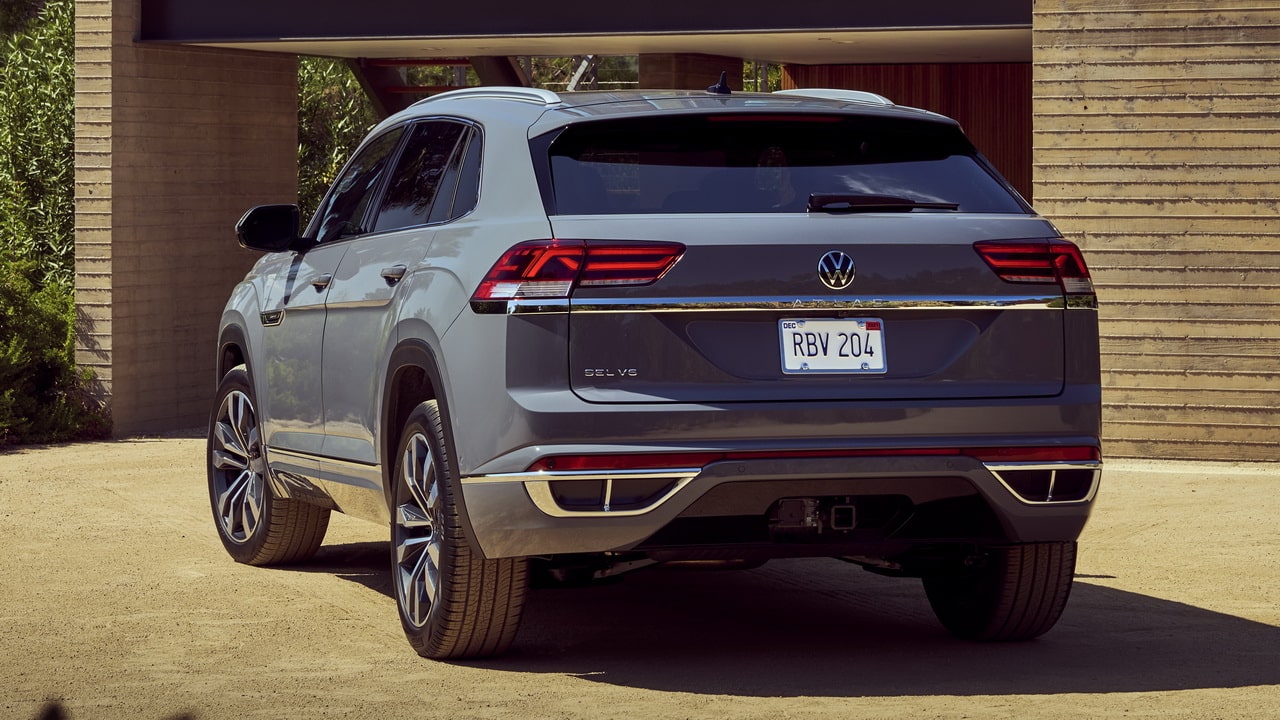
А вот колесная база и ширина остались на своих местах, все-таки платформа та же что и была – 2980 мм и 1979 мм соответственно.
При этом переднюю часть «обрезка» не затронула. Изменилась только корма, где главным образом принесли в жертву объем багажника и сделали другой угол крыши.
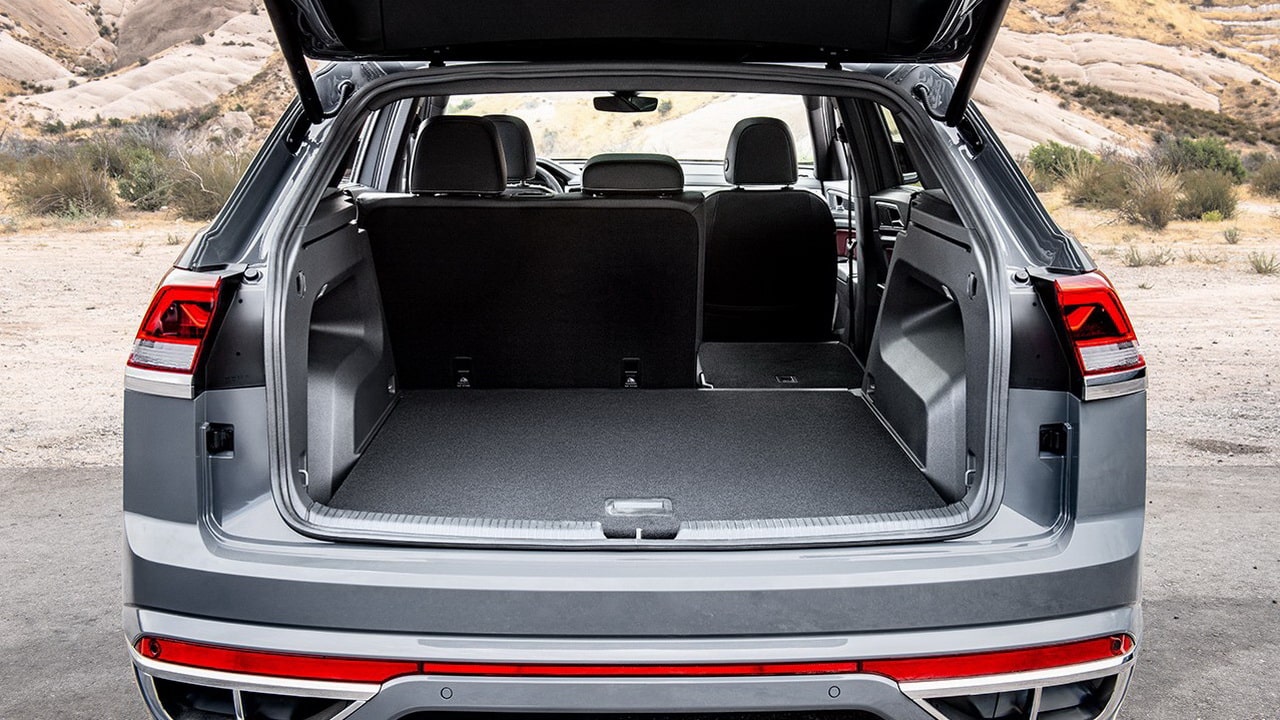
В плане стилистических моментов передняя часть также приобрела несколько другой дизайн. Ведь в отличие от обычного Атласа, разработкой Кросс Спорт занималось подразделение R, которое, кстати, ставит на автомобили свой уникальный логотип.
По передку постарались без лишних элементов. Основной дизайн Атласа был излишне загроможден. Здесь убрать все лишнее, при этом оставили все узнаваемые черты.
Cross Sport получил светодиодную оптику с двумя ячейками, двухслойную решетку радиатора, где в глубине скрывается сетка, а вперед на всю ширину выступает хром. Снизу по традиции идет второй блок, состоящий из С-образных воздухозаборников и центрального диффузора. Вот собственно и все.
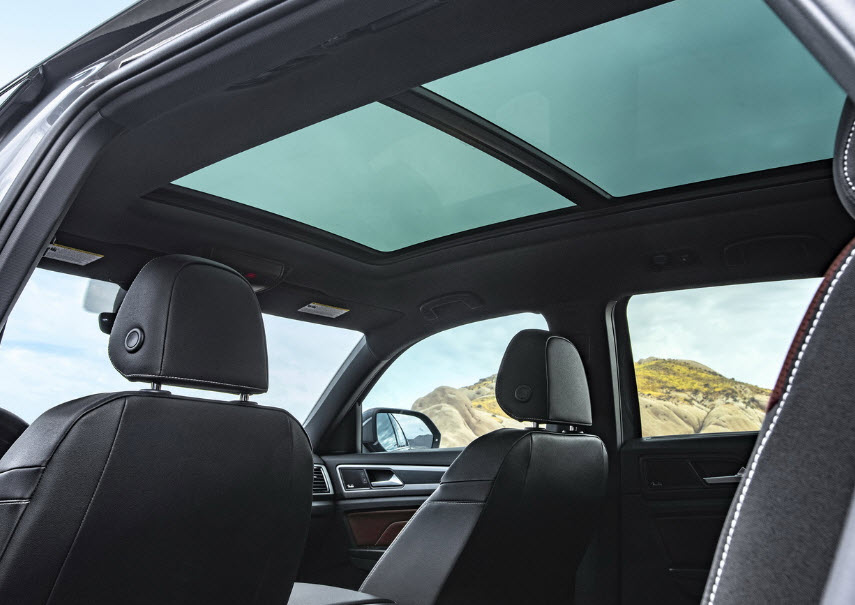
Сбоку можно отметить уже упомянутый измененный угол крыши, новый фирменный рисунок колесных дисков и измененную геометрию колесных арок. Сзади стало больше хрома.
Оставленные в покое габариты подчеркивает хромированная накладка, бампер получил красную полосу стоп-сигналов и еще больше хрома, которыми даже законтурили встроенные насадки выхлопа. Посередине можно отметить нишу, с под которой выглядывает фаркоп.
Салон
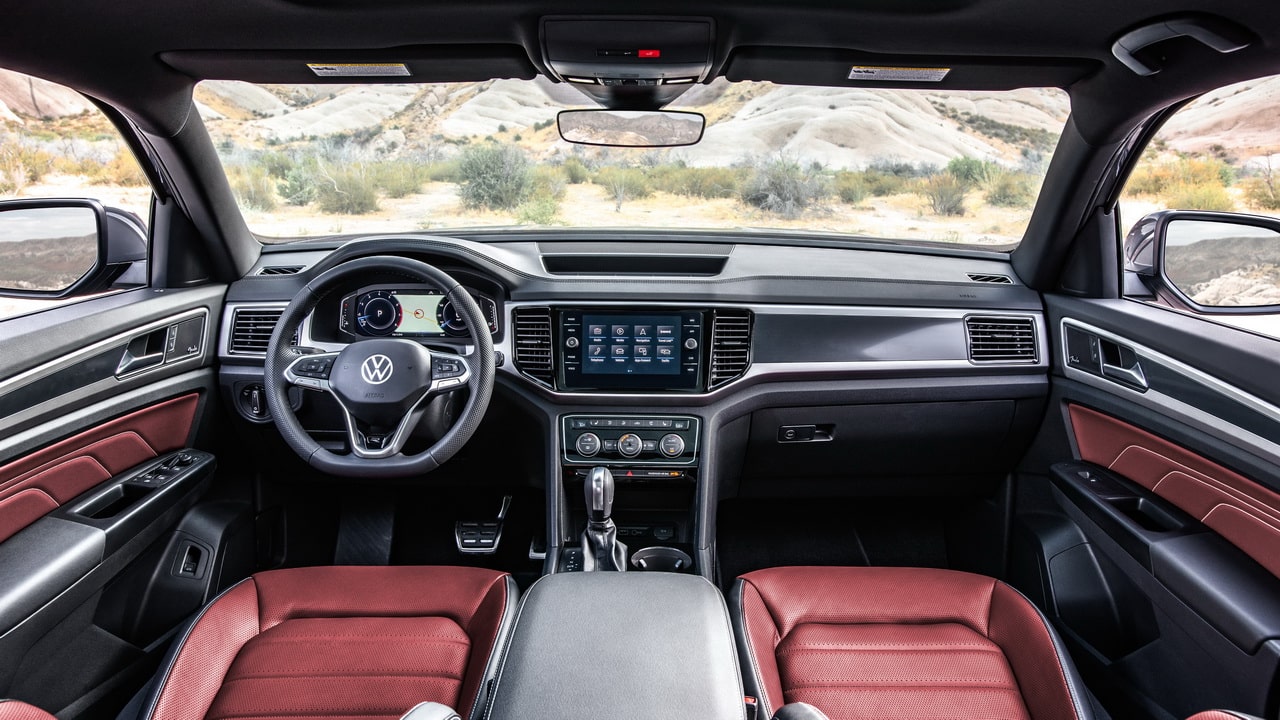
Изменений по части интерьера также хватает.
- Во-первых, нужно было оправдать слово «Спорт» в названии, так что салон представлен в двойной расцветке. Пока известно о сочетании черного и красного цветов.
- Во-вторых, изменилось расположение кресел. При чем в лучшую сторону. Хотя кузов стал короче, места стало больше за счет отсутствия третьего ряда и уменьшенного багажного отделения. Теперь багажник вмещает 1141 литр, вместо 2203 донора.
Также изменения коснулись архитектуры дверных карт, дизайна виртуальной приборки и формы рулевого колеса. В остальном без изменений. Те же спортивные сидения, массивный подлокотник спереди и такой же откидной сзади, интересно оформленные решетки вентиляции и климат-контроля.
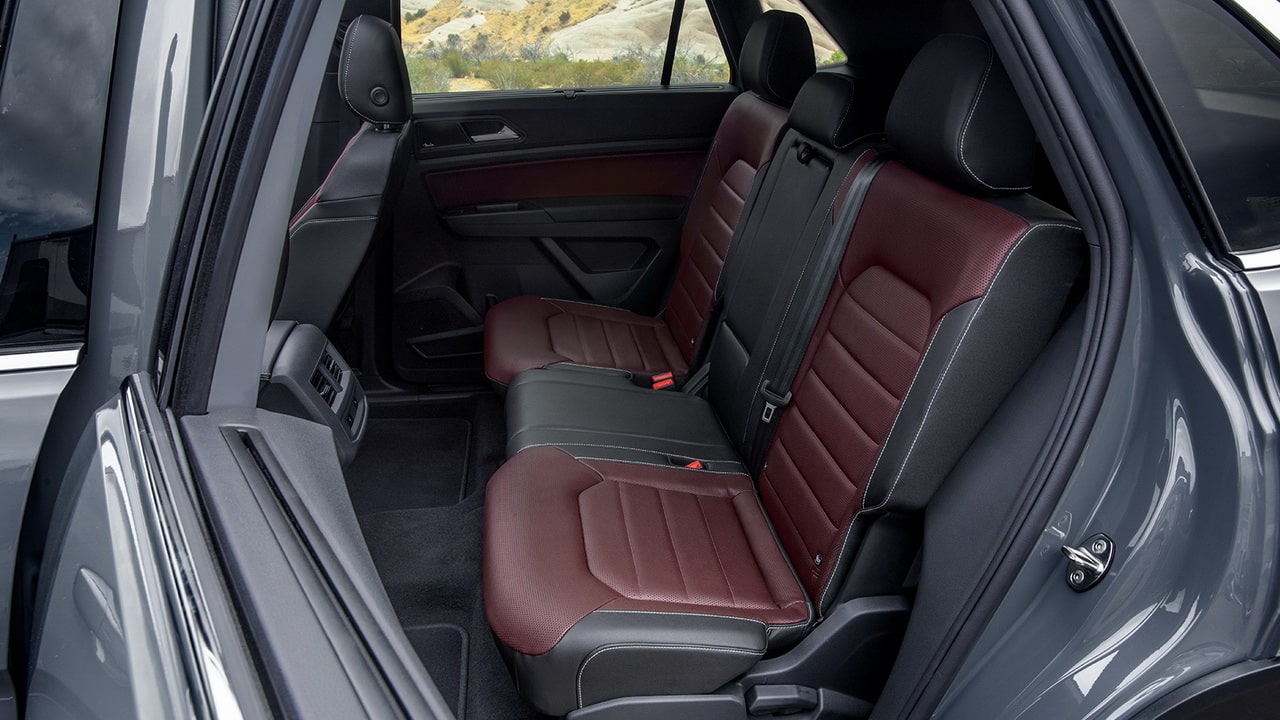
В добавок уже в базовой комплектации Atlas Cross Sport в наличии панорамная крыша (по желанию).
Цена и дата начала продаж
На данный момент Volkswagen Atlas Cross Sport 2020 планируется собирать исключительно для американского рынка. Производственные мощности также находятся на территории США. Нашим автолюбителям скорее стоит ожидать азиатскую версию Teramont, которая продается на китайском рынке, но и этот вариант в нынешних условиях маловероятен.
Американские клиенты будут получать купеобразный Атлас по цене от 1.65 миллиона рублей. Правда к дилерам новинка попадет только в середине года. Немцы до середины весны будут еще настраивать сборочную линию.
Фото нового Volkswagen Atlas:
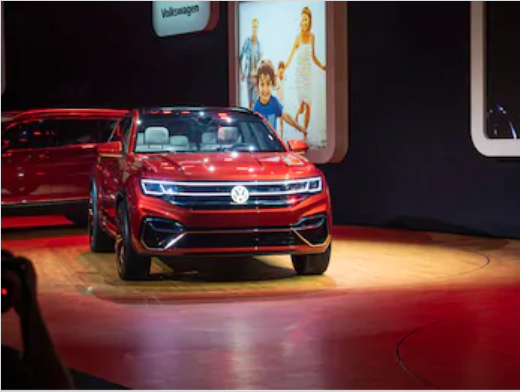
Volkswagen Atlas Cross Sport 2018: концепт купеобразного кроссовера для пятерых
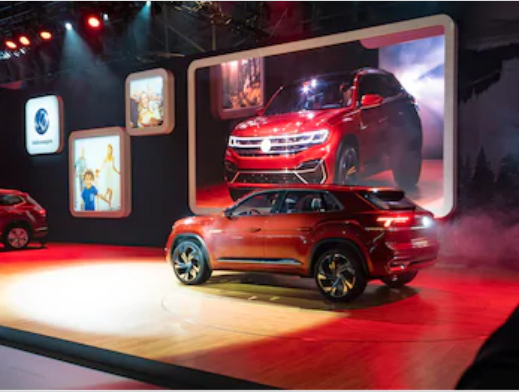 Прошедшая в Нью-Йорке автовыставка в этом году выдалась богатой на новинки. Одной из знаковых в ряду таковых стал небольшой кроссовер Volkswagen Atlas Cross Sport Concept, предваряющий выпуск серийной модели Atlas Cross Sport.
Прошедшая в Нью-Йорке автовыставка в этом году выдалась богатой на новинки. Одной из знаковых в ряду таковых стал небольшой кроссовер Volkswagen Atlas Cross Sport Concept, предваряющий выпуск серийной модели Atlas Cross Sport.
По сведениям от автопроизводителя, машину в серийном исполнении мир увидит в 2019 году. Она должна занять промежуточную ступень меж моделями концерна Tiguan и Atlas, на отечественном рынке именуемой Teramont. Предположительно, ее стоимость будет не более 40 тысяч долларов.
Особенности экстерьера концепта
Дизайнеры бренда постарались на славу, подарив машине с купеобразным укороченным кузовом динамично-стильную внешность. Благодаря роскошной светотехнике машина чрезвычайно эффектно выглядит спереди – внимание привлекают фронтальные светодиодные фары и лед-ленты ходовых огней, плавно переходящие от головной оптики на решетку радиатора.
22-дюймовые колеса концепта имеют притягательный декор и резину отличного качества. Что же до цветового решения авто, по слухам Атлас Кросс Спорт сможет предложить потребителям обширный выбор кузовных расцветок и ряд вариантов колёсных дисков.
Важный момент: кузов оснащенного всеми мыслимыми системами безопасности авто свыше чем на 50% выполнен из стали повышенной прочности и обладает зонами запрограммированного смятия.
Салонный интерьер
 Оформление салона новой модели кроссовера от Фольксваген радует демонстрацией последних достижений производителя как в дизайнерской сфере, так и в плане оснащения оборудованием. Водителю предлагается управлять авто посредством трехспицевого мультируля и пользоваться приборной цифровой панелью, решенной в виде монитора в 12,3 дюйма.
Оформление салона новой модели кроссовера от Фольксваген радует демонстрацией последних достижений производителя как в дизайнерской сфере, так и в плане оснащения оборудованием. Водителю предлагается управлять авто посредством трехспицевого мультируля и пользоваться приборной цифровой панелью, решенной в виде монитора в 12,3 дюйма.
Минималистичная центральная торпеда имеет два сенсорных дисплея: один из них, обладающий 10,1-дюймовой диагональю, позволяет управлять системой мультимедиа и решать навигационные задачи, а второй предназначен для управления климатической системой.
Автовладелец, сидящий за рулем и пассажир справа от него по достоинству оценят комфортные кресла с продуманным боковым поддержанием, подогревом, вентиляцией и еще множеством полезных электрорегулировок.
Для пассажиров, которые будут располагаться в 5-местном салоне сзади, разработчики предусмотрели комфортный диванчик и запас свободного пространства, благодаря внушительной колёсной базе.
Размеры Volkswagen Atlas Cross Sport Concept
 Размеры концепта, если сравнивать с 3-рядным Атласом, изменились не слишком существенно. В длину авто составляет 484,6 см, что на 19 см короче, чем «прародитель». Его ширина увеличилась на 4 см, достишгув 202,9см, а высота, напротив, уменьшилась на 4,4 см – до 173,4см.
Размеры концепта, если сравнивать с 3-рядным Атласом, изменились не слишком существенно. В длину авто составляет 484,6 см, что на 19 см короче, чем «прародитель». Его ширина увеличилась на 4 см, достишгув 202,9см, а высота, напротив, уменьшилась на 4,4 см – до 173,4см.
Колёсная база в 297,9 см актуальна для обоих кроссоверов, равно как и вместительный багажник. Согласно ожиданиям специалистов его объем должен составлять не менее 480 литров.
Особенности и теххарактеристики новинки
 Выстроено авто на фирменной «тележке» бренда MQB. Что же до моторной гаммы, то от «старшего брата» «младшему» достался движок VR6 3.6 (280 «лошадок»), вращающий передние колеса в тандеме с электромотором мощностью 55 сил. На задней же оси стоит 2-й электродвижок с мощностью 116 «лошадей». Пиковая отдача установки — 360 л.с.
Выстроено авто на фирменной «тележке» бренда MQB. Что же до моторной гаммы, то от «старшего брата» «младшему» достался движок VR6 3.6 (280 «лошадок»), вращающий передние колеса в тандеме с электромотором мощностью 55 сил. На задней же оси стоит 2-й электродвижок с мощностью 116 «лошадей». Пиковая отдача установки — 360 л.с.
Литий-ионнй акумулятор на 18 кВт/ч «спрятан» в центральном тоннеле. Подзарядив его от розетки до максимума, согласно обещанию автопроизводителя, можно проехать примерно 42 километра. Машина сможет разогнаться до 100 км/ч не более чем за 5,4 секунды и развить скорость максимум до 209 км/ч. Мощность этого варианта кроссовера составляет 359 сил.
Напоминаем, об акциях на ремонт и сервис Фольксваген в нашем автосервисе АБС-маркет
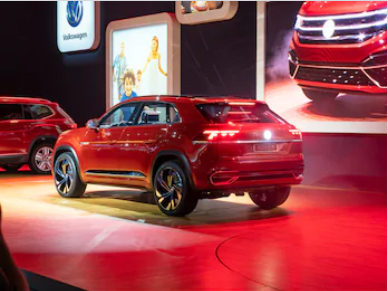 Одновременно был анонсирован гибрид поскромнее. Обладая силовым агрегатом, выдающим 314 силы и батареей, не позволяющей производить подзарядку от электророзетки и вмещающей лишь 2 кВт/ч, он не предусматривает езды на чистом электричестве. На разгон до 100 км/ч такому авто требуется уже 6,5 секунд, однако, максимальная скорость у него такая же.
Одновременно был анонсирован гибрид поскромнее. Обладая силовым агрегатом, выдающим 314 силы и батареей, не позволяющей производить подзарядку от электророзетки и вмещающей лишь 2 кВт/ч, он не предусматривает езды на чистом электричестве. На разгон до 100 км/ч такому авто требуется уже 6,5 секунд, однако, максимальная скорость у него такая же.
Будут ли представлены описанные силовые агрегаты в серийной модели «Атласа», пока остается не ясным. Есть предположение, что кроме 3,6-литрового V6 в Америке авто может укомплектовываться «турбочетверкой» 2.0TSI, чья мощность составляет 235 «лошадок».
Производство 5-го кроссовера будет вестись на заводе в Чаттануге (США), где собирается Atlas и «Пассат». На то, чтобы подготовить производство, компания Volkswagen планирует потратить 340 млн. долл.
2018 Volkswagen Atlas Cross Sport Concept
Volkswagen Atlas Cross Sport Concept
- Concept previews a five-seater Atlas SUV built off the MQB platform
- Production of the five-seater Atlas will start in Chattanooga, Tennessee, in 2019
- Atlas Cross Sport concept is 7.5 inches shorter than the Atlas, retains same wheelbase
- The concept uses a plug-in hybrid drive system, with two electric motors, a V6 gasoline engine, and 355 horsepower
- A conventional mild hybrid drive system would produce 310 horsepower
- Atlas five-seater shows that Volkswagen has a serious SUV strategy
Volkswagen is about to ignite the next stage of its global SUV strategy. After recently showing the new Touareg in Europe and China, Volkswagen is now debuting a new version of the Atlas SUV at the New York International Auto Show: the Atlas Cross Sport concept.
The new Atlas Cross Sport concept is a five-seat version of the midsize SUV that went on sale in the U.S. in 2017 as a seven-seater. The near-production concept car features a coupe-like profile, an even sportier stance, and a plug-in hybrid drivetrain with 355 horsepower and an anticipated 26 miles of all-electric range. A conventional mild hybrid version of the same powertrain would make 310 hp. The actual production vehicle is scheduled to be launched in the U.S. market starting in 2019, and will be built alongside the seven-passenger Atlas and the Passat sedan in Chattanooga, Tennessee.
An innovative range of SUVs is an important element in Volkswagen’s growth strategy for the U.S. market, alongside new products such as the 2019 Jetta. The latest sales figures show the importance of the new SUV models: In February, 54 percent of Volkswagen’s American customers chose a Tiguan or an Atlas. Volkswagen of America will further increase the market share of its SUV fleet with new models such as the production version of the Atlas Cross Sport concept and the all-electric I.D. CROZZ that has been announced for 2020.
Design
The concept vehicle is 190.8 inches long, 68.3 inches tall and 79.9 inches wide. The powerful exterior is marked at the front by a two-bar grille instead of the three bars on the seven-passenger Atlas. In both vehicles, the LED headlights and LED Daytime Running Lights (DRLs) are an integral part of the radiator grille and a key feature of the new midsize Volkswagen SUV family. Unlike the Atlas seven-seater, the grille crossbars are also illuminated in white and operate as LED DRLs.
The profile of the Atlas Cross Sport concept combines powerful proportions with sleekly raked C-pillars, as well as short front and rear overhangs. The roof spoiler, which has black side fins, is another distinctive element. The way that the character line transitions directly into the wide, flared wheelarches serves to emphasize its power and presence.
The rear wheelarch on the driver’s side features the ‘filler cap’ for connecting the charging plug for the lithium-ion battery; the one on the other side houses an actual fuel filler neck. The 22-inch aluminum-alloy wheels, which are shod with 285/40 tires, have high-gloss polished spokes for a truly premium look.
After flowing through the wheelarches, the character line transitions into an aluminum accent at the rear of the vehicle. LED taillights are positioned above this trim line. The horizontal design motif continues with an aluminum trim piece that extends laterally across the bumper, and into exaggerated tailpipe surrounds, which mirror the taillights above. The vehicle features a low sill height of 33.3 inches for ease of loading.
Interior
Inside the Atlas Sport Cross concept, the horizontal design remains dominant, emphasized by the instrument panel and infotainment screens. The infotainment system touchscreen is located high on the instrument panel and is seamlessly integrated. The driver and front passenger can manage all infotainment functions and the basic vehicle configuration via a 10.1-inch touchscreen with proximity sensors and gesture control. The layout of the graphics changes depending on which driving profile is selected— ‘Snow,’ ‘Sport,’ ‘On-road’ or ‘Off-road’.
Navigation data can be displayed in a two-dimensional or three-dimensional form. In the 3D view, the user has the option of configuring an individual display layout, which can be done on three or more levels that hover above one another in virtual space. Each level shows the map and position of the vehicle, but with different information. On the top level, the driver can configure the Points-of-Interest (POI); the middle level has geographic information such as the current elevation above sea level; the lower ‘Car’ level shows the route and the position of the vehicle.
The 12.3-inch Volkswagen Digital Cockpit has a resolution of 1,440 x 540 pixels, enabling sophisticated and interactive graphics. These graphics change according to the selected drive mode—for instance, if you are in ‘E-Mode,’ driving on electric power. The Digital Cockpit display can be reconfigured to show information on driving, navigation and assistance functions as necessary. The driver can also transfer data shown on the touchscreen, such as telephone contact images or CD covers, to the display.
The area below the infotainment system and the Digital Cockpit is upgraded by a horizontal trim strip made of brushed aluminum, which runs across the whole width of the interior. As with the infotainment system, a touchscreen is used for climate control settings, including those for the seat heating and ventilation.
On the left-hand side of the center console, the selector lever for the 6-speed DSG® automatic transmission has shift-by-wire functionality. It is always in a central position. Short clicks activate the ‘R,’ ‘N’ and ‘D’ settings. A separate button integrated in the selector lever is used to switch to the ‘P’ position.
Behind the DSG shift lever is the 4MOTION® Active Control that offers ‘On-road,’ ‘Off-road,’ ‘Sport’ and ‘Snow’ driving profiles. This selector has a high-tech design with an HD display and transparent ‘light pipe’ elements that conduct LED light. Between the DSG selector lever, driving profile selector and cupholders are the black hard keys for ‘ESC,’ ‘E-Mode’ and ‘GTE-Mode’ and the aluminum ‘Start/stop engine’ button. Two cupholders are positioned to the right of the DSG selector lever where they are easily accessible.
There is one more functional console in the front of the cabin. In the roofline area, there are touch buttons that control the panoramic glass sunroof, a matching sunshade and interior light functions.
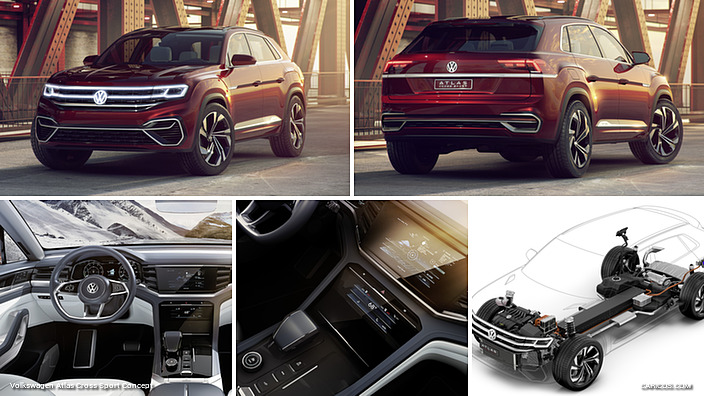
Volkswagen Atlas Cross Sport Concept
Powertrain
Since the Atlas is based on Volkswagen’s modular transverse matrix (MQB), it can be built with all manner of drive systems, including a plug-in hybrid drivetrain. The Atlas Cross Sport concept uses the same 3.6-liter V6 FSI® engine as the Atlas, making 276 horsepower and 266 pound-feet of torque. In the Cross Sport concept, this engine is boosted by two electric motors. The front motor develops 54 hp and 162 lb-ft, and the rear motor makes 114 hp and 199 lb-ft.
Energy for the motors is supplied by a compact 18.0 kWh lithium-ion battery housed in the center tunnel. The drive system’s total power amounts to 355 hp, which potentially enables the Cross Sport concept to accelerate from 0 to 60 mph in just 5.4 seconds. The top speed is 130 mph.
The Atlas Cross Sport concept could also feature a mild hybrid powertrain. Using the same V6 engine and electric motors, but with a smaller 2.0 kWh battery, the mild hybrid version would produce 310 horsepower and give 0 to 60 mph acceleration in 6.5 seconds. The top speed would remain at 130 mph.
The Atlas Cross Sport PHEV concept can be driven in any of five modes: ‘E-Mode’, ‘Hybrid’, ‘GTE,’ ‘Off-road’ or ‘Battery Hold / Battery Charge’.
- ‘E-Mode’. The Atlas Cross Sport concept always starts out in the all-electric ‘E-Mode’ provided that the battery is sufficiently charged. The all-electric driving range is up to 26 miles. In E-Mode, the vehicle’s drive power is exclusively supplied by the 114 hp electric motor at the rear axle. In all-electric mode, the gasoline engine is decoupled from the drivetrain by disengaging the clutch, and it is shut off. As soon as the V6 needs to be engaged again, it is coupled to the drivetrain in a nearly imperceptible process. A power electronics unit manages the flow of high-voltage energy from and to the battery and to the electric motors. The 12-volt vehicle electrical system is supplied by a DC/DC converter. The battery is charged via external power sources or while driving.
- ‘Hybrid’. As soon as the battery’s voltage drops below a certain charge, the Atlas Cross Sport concept switches to ‘Hybrid’ mode. The hybrid version would always start in this mode. Depending on the driving situation, it automatically engages the V6 and/or the rear electric motor. If the driver removes his or her foot from the accelerator or brakes when the battery is not sufficiently charged, both electric motors operate as generators and feed energy recovered from braking into the lithium-ion battery. When the gasoline engine alone is powering the vehicle, the concept car is exclusively a front-wheel drive vehicle. However, the rear axle is rapidly engaged again as soon as the driving situation demands it.
- ‘GTE’. The driver uses the GTE button to switch to GTE mode, which makes the throttle map, gearshifts and steering even sportier. In addition, the V6 and the electric motors work together in ‘GTE Mode’ during ‘boosting’ to access the full system output and the maximum system torque of 494 pound-feet.
- ‘Off-road’. As soon as the driver activates the ‘Off-road’ mode, the Atlas Cross Sport concept becomes an all-wheel drive vehicle. In this case, and when the battery’s state of charge is low, the front electric motor—now supplied with energy by the V6 gasoline engine—is employed exclusively as a generator and is the energy source for the electric motor on the rear axle. Because the energy for driving the rear wheels is transferred ‘by wire’ and not mechanically, it is referred to as an ‘electric propshaft’. Due to the fact that, in Off-road mode, the gasoline engine drives the rear electric motor via electrical energy from the front electric motor, this all-wheel drive configuration is even available if the battery has a low state of charge. This gives the plug-in hybrid SUV very impressive off-road ability.
- ‘Battery Hold / Battery Charge’. The dual mode ‘Battery Hold’ (energy content of the battery stays constant) and ‘Battery Charge’ (battery is charged while driving) is activated from a menu in the infotainment system. It might be used, for example, to intentionally prepare for driving in the all-electric mode (‘E-Mode’), which could be required in a city of the future.
In addition to all the above modes, the 4MOTION Active Control offers seven different driving profiles in the Atlas Cross Sport concept: ‘On-road’ (‘Comfort’ and ‘Eco’ modes), ‘Off-road’ (‘Rocks,’ ‘Sludge & Sand’ and ‘Gravel’ modes), ‘Sport’ and ‘Snow’.















